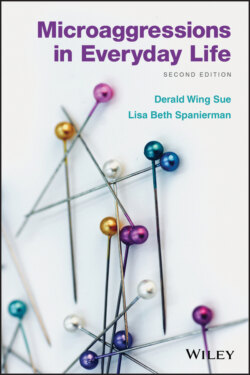Читать книгу Microaggressions in Everyday Life - Derald Wing Sue - Страница 8
CHAPTER ONE Microaggressions as Toxic Rain: Here, There, and Everywhere! “Still I Rise”
ОглавлениеYou may write me down in history
With your bitter, twisted lies,
You may tread me in the very dirt
But still, like dust, I'll rise.
..............................................
You may shoot me with your words,
You may cut me with your eyes,
You may kill me with your hatefulness,
But still, like air, I'll rise.
Maya Angelou
Written by Maya Angelou, a renowned African American poet, writer, and Civil Rights advocate, the poem “Still I Rise” both empowers and validates those who have suffered oppression, abuse, bullying, humiliation, and injustice and pricks the conscience of “oppressors” for the hurt and pain caused by their racial prejudice and discriminatory actions. It is also a testament to the courage, resilience, and strength of African Americans in their ability to survive and thrive in the face of constant hatred and bigotry. Although written primarily about the lived experience of Black individuals in the United States, the poem has universal appeal and application to all persons of color and to members of socially marginalized groups in our society.
There is perhaps no better way to introduce the topic of microaggressions than in these two selected passages. Most people who read the poem believe Maya Angelou is referring to overt and conscious displays of racism or hate crimes associated with bigots or White supremacists. That, however, is only a small part of the meaning of “Still I Rise.” In this poem and in her other writings, Angelou also addresses the everyday racism expressed by well‐intentioned, dominant‐group members who experience themselves as good, moral, and decent human beings, who would never consciously discriminate against people of color. Although she never used the term “microaggressions,” Angelou likened the everyday slights and indignities to “little murders” as distinct from the “grand execution” (hate crimes). These everyday and seemingly innocuous insults and putdowns (microaggressions) are what she labels “death by a thousand cuts.” The two passages indicate how microaggressions are manifested in the educational curriculum of our schools (“You may write me down in history with your bitter twisted lies”), verbally (“You may shoot me with your words”), and nonverbally (“You may cut me with your eyes”). In other words, microaggressions may be delivered contextually, verbally, and nonverbally. Let us use two examples to illustrate the manifestation, dynamics, and impact of microaggressions.
What do these incidents have in common? How does Maya Angelou's poem relate to these two cases? In both examples, individuals with power deliver subtle, perhaps unconscious, microaggressions. In Example 1.1, a well‐intentioned professor delivered racial microaggressions, and in Example 1.2, a commuter on the train and the vice president both delivered gender microaggressions. “Still I Rise” represents resilience of the targets. Before we analyze these two examples in greater depth, let us first define microaggressions in greater detail.
